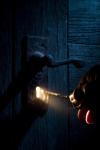Duke Bluebeard’s Castle
A newlywed couple and seven fatal questions: Duke Bluebeard’s Castle is a genuine psychological thriller.

How much truth can we bear in the name of love? That is the question at the heart of Duke Bluebeard’s Castle, a genuine psychological thriller. A newlywed couple and seven fatal questions; this is all the story needs to make the tension unbearable for the listener. The overpowering music, in which Bartók makes masterful use of all the registers of the orchestra, does the rest. Not to be missed.
Bartók's score prescribes lighting effects: a different color with each new door Judith opens. Lighting designer Paul van Laak has created a new lighting design for this occasion, making optimal use of the possibilities of the main hall of De Doelen, so that the thriller content of Bartók's opera becomes even more exciting.
Duke Bluebeard's Castle is sung in Hungarian and contains Dutch and English surtitles.
Programme & performers
Ligeti
Atmosphères
Bartók
Duke Bluebeard’s Castle



No musical piece leaves the listener with more questions than answers like this opera by the Hungarian genius Béla Bartók. Duke Bluebeard’s Castle is a peculiar musical piece. Contrary to other operas, its plot is not an ordinary love story and scenery – we won't see a dramatic romance on stage. Instead, Bartók gave us this musical thriller.
The story has its roots in a French fairy tale with the same name by Charles Perrault. In the 20th century, the classic tale was the subject of new interpretations. Under the influence of symbolism, subconsciousness, and the emergence of the field of psychology, it was reinterpreted with a new mysterious and dark meaning. A foundation for Bartok’s opera came out of the pen of Hungarian librettist and poet Béla Balázs, a close friend of the composer.
What is Duke Bluebeard’s Castle about?
All attention of the opera is drawn to the two main characters, Bluebeard and his new 'wife’ Judith. Even though the opera's libretto doesn't state the marital status of Bluebeard and Judith, there are many connotations and theories stating it. What is quite apparent - the rumours around the mysterious Duke: what has happened to his previous wives? Are they still alive? Despite evil rumours, Judith decides to leave her family and stay by Bluebeard's side.
Deprived of the company of servants and other inhabitants of a fairy-tale land, a young Judith starts a new life with a mysterious duke in his distant castle. The Bluebeard's castle stands at the centre of the plot as it is the only setting for this opera. Like the relationship of the main characters, it has a symbolic meaning, which gradually reveals its cherished awe-inspiring and terrifying secrets to the listener.
What does it sound like?
The opera is built in the form of a psychologically expressive dialogue; it is abundant with fluid, intensely expressive recitatives, which skilfully translate the characteristic manner of Hungarian musical folk motifs. Bartók’s vibrant music sparkles with subtle nuances, woven from a variety of original, sometimes daring in innovation, expressive techniques. With the help of these techniques, the composer skilfully writes out a mysterious, gloomy-fantastic, picturesque background against which the opera's actions unfold. With each new scene uneasiness in the air is only building up, the colours thicken and darken on the stage. In the dramatic climax of the opera, the orchestra sounds especially powerful and gloomy. A true musical thriller for your ears that must be heard live!
A psychological thriller

Wondrous and mysterious… an experience that goes further than an ordinary concert.




